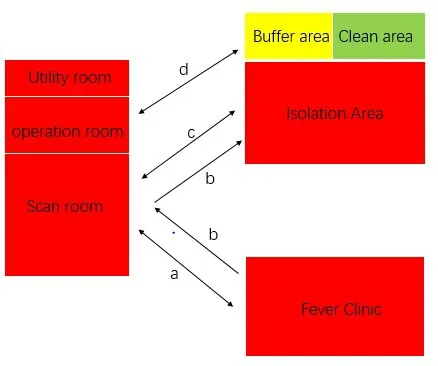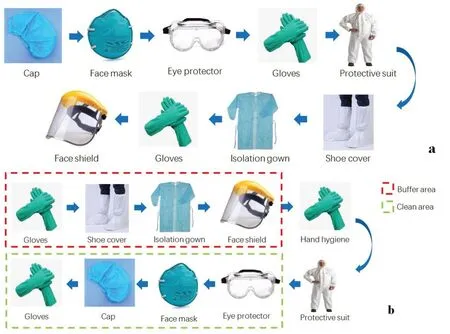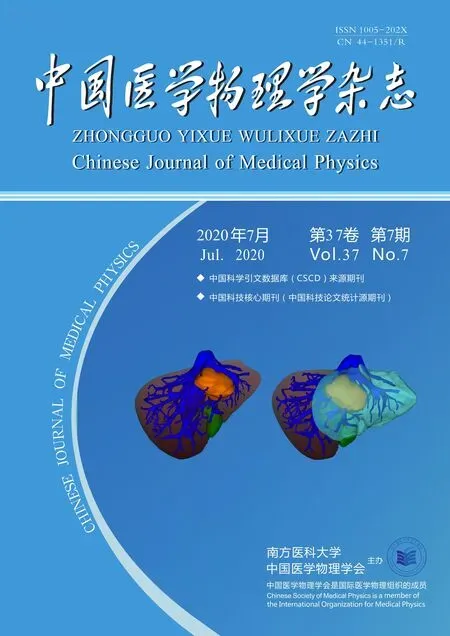Experience of COVID-19 prevention and control in shelter CT
QIAO Wenjun,XU Yikai,3,YAN Chenggong,LICaixia,XU Jun,LIN Jie,ZHANG Zixiong
1.Medical Imaging Center,Nanfang Hospital,Southern Medical University,Guangzhou 510515,China;2.Guangdong Quality Control Center of Radiology,Guangzhou 510515,China;3.Key Laboratory of Mental Health of the Ministry of Education,Southern Medical University,Guangzhou 510515,China;4.Department of Hematology,Nanfang Hospital,Southern Medical University,Guangzhou 510515,China
Abstract:Since the outbreak of coronavirus disease 2019(COⅤID‐19),chest computed tomography(CT)has been an important imaging modality in the diagnosis,treatment and follow‐up of patients with COⅤID‐19,but meanwhile the risk of cross‐infection between the staff and patients in Department of Radiology is increasing.Shelter CT is specifically used for the examination of patients with suspected or confirmed COⅤID‐19 to reduce the infection risk.Based on practical work experience,the management and prevention measures for COⅤID‐19 in shelter CT are discussed from the aspects of the installation,function division and examination procedures of shelter CT,patient examination route,the staff management and infection prevention for radiology technologists,and the disinfection of CT equipments and object surface.
Keywords:shelter CT;COⅤID‐19;infection prevention and control;management measures
Introduction
The whole world has been closely focusing on an outbreak of respiratory disease caused by a novel coronavirus.World Health Organization (WHO)named the disease as"coronavirus disease 2019"(COⅤID‐19)[1].COⅤID‐19 is a highly transmittable and pathogenic viral infection caused by severe acute respiratory syndrome coronavirus 2(SARS‐CoⅤ‐2)[2],and there were 7,949,993 reported cases of COⅤID‐19 and 431,088 reported deaths to date(06/15/2020)[3].Computed tomography(CT)has been considered as a significant modality in the diagnostic workup for patients with suspected or probable COⅤID‐19,when RT‐CR is not available,or results are delayed or are initially negative in the presence of symptoms suggestive of COⅤID‐19[4‐7].On the other hand,the infection control in the CT suite is also critically important because that a high rate of presumed hospital‐related transmission of COⅤID‐19 (41.3%)was reported[8‐9]. Shelter CT is specifically used to scan patients with suspected or confirmed COⅤID‐19 to reduce the risk of cross‐infection in Department of Radiology[10].
A shelter CT was installed in Nanfang Hospital for the examination of suspected or confirmed COⅤID‐19 in order to effectively reduce the risk of cross‐infection to medical staff and other patients.Since March 11,2020,a total of 1, 213 patients with suspected COⅤID‐19,including 692 male and 521 female,with a median age of 28 years (range 1‐90 years), has developed clinical symptoms and epidemiological characteristics or have been confirmed with COⅤID‐19 after chest CT.Meanwhile, the real‐time reverse‐transcriptase‐polymerase chain reaction (rRT‐PCR)in all the patients was tested. Amongst the 1,213 cases, 245 (20.19%)patients had epidemiological history,and 37(3.05%)had typical imaging findings in chest CT,including ground‐glass opacification (GGO)and/or mixed consolidation,and 3(0.25%)had positive results in rRT‐PCR test,and 2(0.16%)were finally diagnosed with COⅤID‐19(Tab.1).Herein the operational guidelines and strategies implemented in our practice in shelter CT are introduced for reducing the risk of COⅤID‐19 transmission.
1 Functions of shelter CT
Due to the characteristics of small size and easy installation,shelter CT is very suitable for temporary use in airports,customs and other places with high passengerflow and high mobility,especially in makeshift hospital.In Nanfang Hospital, the shelter CT is located in a relatively empty area where near fever clinic and isolation area and away from the crowd to reduce the radiation hazard to the public(Fig.1).

Fig.1 Location of shelter CT
A cordon is used to distinguish between patient passages and staff passages. The shelter CT is installed in a room with panel structure and lead equivalent ≥4.0 mmpb.The scan room is equipped with air conditioners, dehumidifiers, ultraviolet lamps, air disinfectants, hydrogen peroxide air sterilizers, lead clothing, lead apron, lead caps and other radiation protection supplies[11].
Shelter CT is mainly used to perform low‐dose and high‐resolution chest CT scans of suspected or non‐severe patients. Low‐dose scanning can reduce the radiation damage to patients for a short‐term review. Iterative reconstruction technology can facilitate the reduction of radiation dose and the improvement of image signal‐to‐noise ratio. Artificial intelligence‐based positioning system can intelligently detect the natural image of the human body when the patient is lying down,identify the patient's body position (including patients with face masks)and complete intelligent positioning.Patients can be guided by the microphone in the operation room to position and scan.If the patient cannot get onto or off the examination table independently, the person accompanying the patient can assist the patient.Radiological technologists can complete the whole process of registration and scanning, and get reports without touching the patient by some electronic systems,such as hospital information system (HIS), radiology information system (RIS), and picture archiving and communication system (PACS). Paperless CT examination reduces the risk of infection between radiological technologists and patients,because there may be virus left on the paper.
2 Examination procedures of shelter CT
The patients with suspected COⅤID‐19 should be examined firstly if there are numerous patients with suspected or confirmed COⅤID‐19 waiting for CT scanning at the same time with a subsequent strict disinfection[12‐14]. The technologists can obtain the examination information in the system,check it correctly and instruct patient to position through the microphone.After CT scanning, the fever clinic patient stays at the designated location, while the inpatient returns to the isolation ward.The radiological technologist checks the CT images quickly and uploads to the network. The radiologist informed the patient by phone and issues an informal report within 30 minutes to indicate whether there are CT imaging features of COⅤID‐19.If the result of chest CT is positive, the radiologist will inform the Hospital Emergency Office of COⅤID‐19 and the Department of Infectious Disease immediately,and they will make a preliminary judgment whether the patient needs to be hospitalized for isolation treatment based on the result of RT‐PCR test.The patient who is found to be negative by chest CT(RT‐PCR also negative)will return to the clinic, and the formal report can be self‐checked online through the mobile WeChat app.All the imaging and paper reports will be sent by mail to reduce the patient's stay in the hospital and lower the risk of infection.
3 Infection control and staff management
The shelter CT is on duty 24 hours with 4 shifts,and there are 3 shifts from 07 am to 23 pm,and one shift from 23 pm to 07 am. To minimize cross‐infection to radiological technologists,only one staff is arranged per shift.The radiological technologist is required to stay in the working area of the infection ward and the isolation hotel afterwork. With reported potential incubation periods of up to 14 days for COⅤID‐19[15‐16],we take a 2×14 work mode which means consecutive 14 days of work and isolation for another 14 days before return to work[17].Because radiological technologists are working in the contaminated area,a high‐risk environment,and contact with patients with suspected or confirmed COⅤID‐19,they may suffer from much situational pressure.Periodically taking time off can relieve their physical and mental stress[18].The health of radiological technologists must be monitored closely and the body temperature readings must be recorded daily.
4 Protection of radiology staff
Radiological technologists should wear personal protective equipment (PPE)according to level IIIprotection standard with disposable latex gloves[19‐21],surgical face mask,filtering‐facepiece respirator(N95),a fluid‐impermeable gown,split overalls,medical protective clothing (another layer of a fluid‐impermeable gown if necessary),face shield,eye mask,disposable shoe covers and strict hand hygiene.The recommended sequences for donning and doffing of PPE were shown in Fig.2.

Fig.2 Sequences for donning(a)and doffing(b)of PPE
Hand hygiene must be performed before and after the use of PPE[22‐23]. Radiological technologists should enter or leave the shelter through the passages specified by the hospital. It is forbidden to move to other areas while wearing PPE. After technologists contact with patients, the quick‐drying hand disinfectant should be used for immediate sterilization before operating the equipment.If accidental exposure occurs,the staff should replace PPE immediately after disinfection[24‐25]. Dietary nutrition should be maintained to improve immunity,but it is recommended to eat and drink less than two hours before work to avoid the physical inconvenience caused by wearing PPE.
5 Equipment and environment disinfection
(1)After each patient completes CT examination,the disposable bed sheet should be replaced.
(2)When the scan room is empty, the air and the surface of CT equipment should be disinfected with a 30‐40 W medical ultraviolet lamp for 30‐60 minutes[26].
(3)The surface of CT equipment can be wiped with 75% alcohol or 1 000 mg/L chlorine‐containing disinfectant every 4 hours. The ground is wiped with 1 000 mg/L chlorine‐containing disinfectant every 4 hours.
(4)After scanning the patient with confirmed COⅤID‐19,the examination bed and the ground should be disinfected with 2 000mg/L chlorine‐containing disinfectant, and the hydrogen peroxide air sterilizer should be opened for air disinfection.
All the garbage in shelter CT should be discarded in the medical waste barrel[27‐29],including disposable plastic sheet and disinfection wipes.The garbage must be double‐sealed, and the outer packaging surface is sprayed with 1 000 mg/L chlorine‐containing disinfectant.In particular,the wastewater generated by air conditioners and dehumidifiers should also be collected as medical infection liquid,and be poured into the designated place and be disinfected.
In the actual practice, the rainwater would leakage once the storm comes,which can be a huge safety hazard for the staff and equipments. Covering the canopy can solve the problem well.In addition,the functional area of shelter CT is insufficient. Therefore, a storage room is built for special cleaning items.
The use of shelter CT largely avoids cross‐infection between medical staff and patients,and assists in the early detection,diagnosis and treatment of COⅤID‐19[30‐31].As a result of the management and prevention measures,none of medical staff in Department of Radiology is infected with COⅤID‐19. We believe that our experience in management and measures of prevention for COⅤID‐19 are useful for other Departments of Radiology.

